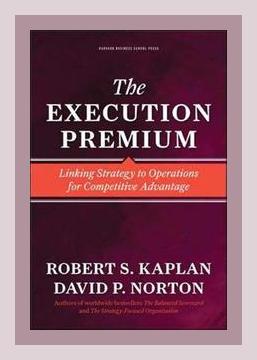Business StrategyInnovation and CreativityStrategic ExecutionStrategic PlanningR&D Management
**
Introduction
Kaplan and Norton’s “The Execution Premium” focuses on bridging the chasm between strategy formulation and operational execution. They introduce the concept of an ‘execution premium’—the tangible benefits that arise when an organization successfully integrates its strategic planning with day-to-day operations. Leveraging the Balanced Scorecard, originally devised by the authors, they argue that companies can transform their strategic visions into real-world successes. The book serves as a practical guide for managers, enriching the realms of R&D Management, Strategic Planning, and Strategic Execution.
Chapter 1: The Strategy Management System
Key Point: The authors present a comprehensive strategy management system comprising six stages—developing the strategy, planning the strategy, aligning the organization, planning operations, monitoring and learning, and testing and adapting the strategy.
Example: They cite the case of Mobil North America Marketing and Refining, which successfully utilized the Balanced Scorecard framework to transform its strategic objectives into operational execution.
Action: Managers should develop a strategy map that clearly defines their organizational objectives and the cause-and-effect relationships among them, ensuring that all departments are aligned to the overarching strategy.
Chapter 2: Developing the Strategy
Key Point: Crafting a robust and coherent strategy involves understanding the external environment, defining a competitive advantage, and setting clear, achievable objectives.
Example: At Cigna Property & Casualty, strategic clarity enabled the company to focus on market segments where they could achieve a competitive edge, leading to significant market share growth.
Action: Conduct a SWOT analysis to identify strengths, weaknesses, opportunities, and threats. Leverage this analysis to define a unique value proposition that addresses both market demands and competitive dynamics.
Chapter 3: Planning the Strategy
Key Point: Strategic planning should translate vision into actionable goals, setting clear priorities and allocating resources accordingly.
Example: Best Buy developed strategic themes—such as customer centricity—that were broken down into specific goals and KPIs, facilitating a focused and measurable execution approach.
Action: Create a strategic roadmap that outlines critical milestones, resource allocation, and timelines. Regularly review and adjust this roadmap to ensure alignment with evolving market conditions.
Chapter 4: Aligning the Organization
Key Point: Effective strategy execution requires alignment across all organizational levels, from senior executives to operational teams.
Example: At Statoil, alignment was achieved through a well-structured Balanced Scorecard that cascaded objectives and measures to departmental and individual scorecards.
Action: Develop cascading scorecards and performance measures that translate high-level strategic goals into specific departmental and individual targets. Hold regular strategy review meetings to ensure continuous alignment.
Chapter 5: Planning Operations
Key Point: Operational planning bridges the gap between strategic objectives and day-to-day activities, detailing how resources will be deployed and operations will be managed.
Example: At UPS, operational planning included investment in technology and process improvements that directly supported their strategic objective of operational excellence.
Action: Integrate financial budgets and operational plans with strategic goals. Use activity-based costing to accurately allocate resources and expenses, ensuring that all operational activities contribute to strategic priorities.
Chapter 6: Monitoring and Learning
Key Point: Continuous monitoring and feedback loops are critical to adapt and refine strategies and operational plans dynamically.
Example: At FMC Corporation, balanced scorecards provided real-time data and insights, allowing for timely interventions and course corrections.
Action: Implement regular performance reviews and use dashboards to monitor key performance indicators (KPIs). Encourage a culture of learning by analyzing successes and failures to foster continuous improvement.
Chapter 7: Testing and Adapting the Strategy
Key Point: Organizations need to remain flexible, testing hypotheses about their strategy and adapting based on real-world outcomes and feedback.
Example: Analog Devices tested various strategic initiatives in pilot locations to assess effectiveness before full-scale rollouts, allowing for data-driven decision-making.
Action: Develop pilot programs for new strategic initiatives to evaluate their viability. Use analytical tools to assess pilot outcomes and adjust the broader strategy based on findings.
Conclusion
“The Execution Premium” illustrates that the true power of organizational strategy lies not just in its formulation but in its execution. By integrating strategic planning with operational activities through a structured management system, organizations can achieve significant competitive advantages. The book’s practical examples and actionable steps provide a roadmap for managers to successfully bridge the gap between strategy and execution, fostering a cohesive and dynamically responsive organization.
Overall Action Plan:
- Develop Strategy: Use SWOT analysis to craft a unique value proposition.
- Plan Strategy: Create a strategic roadmap with clear milestones and resource allocation.
- Align Organization: Implement cascading scorecards and hold regular strategy review meetings.
- Plan Operations: Integrate financial and operational plans with strategic goals using activity-based costing.
- Monitor and Learn: Set up dashboards and performance reviews for continuous monitoring.
- Test and Adapt: Develop pilot programs and adjust strategy based on real-world data.
By following these steps, organizations can not only design robust strategies but also ensure their effective execution, thereby achieving the coveted execution premium.
Business StrategyInnovation and CreativityStrategic ExecutionStrategic PlanningR&D Management
